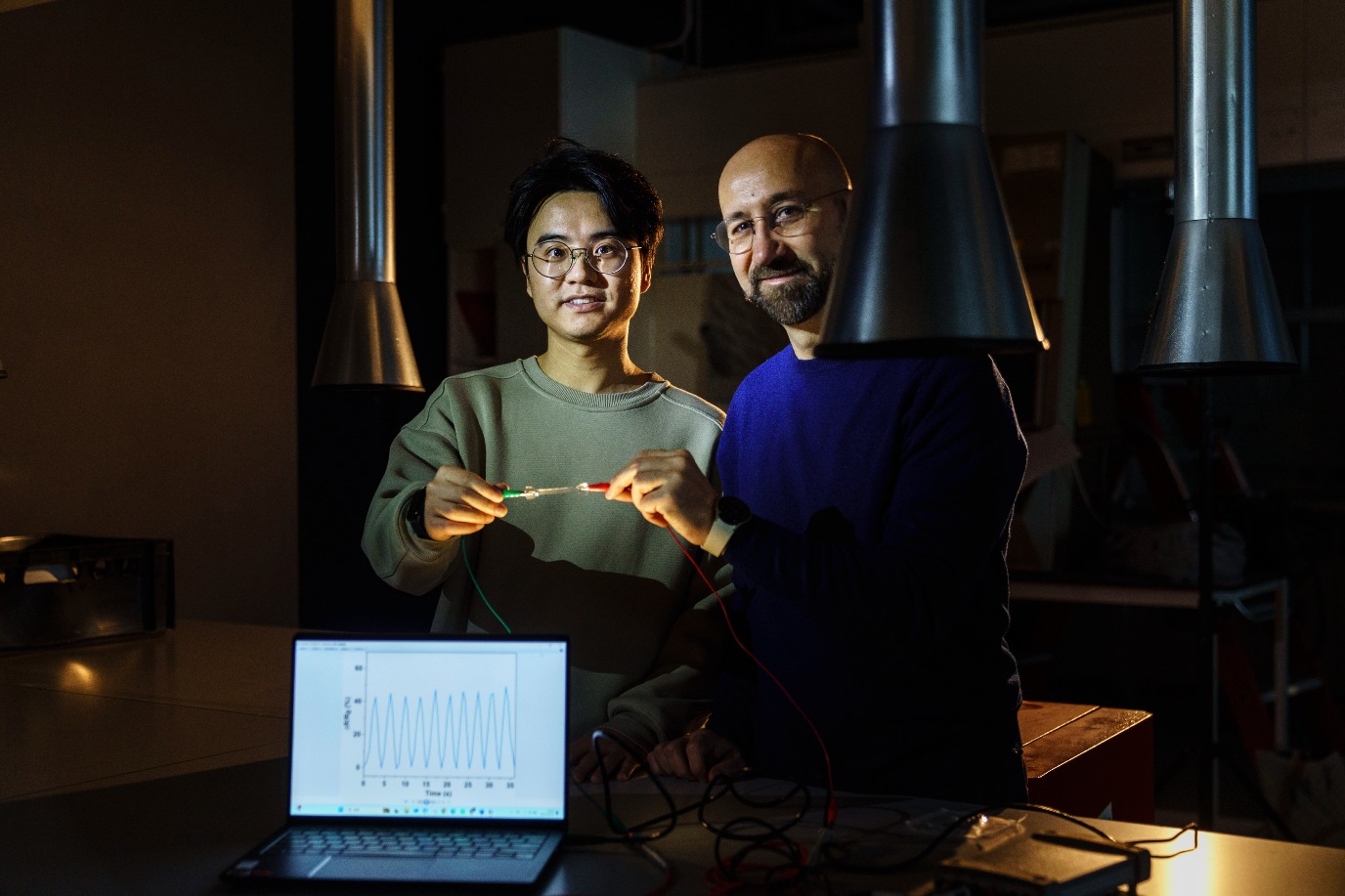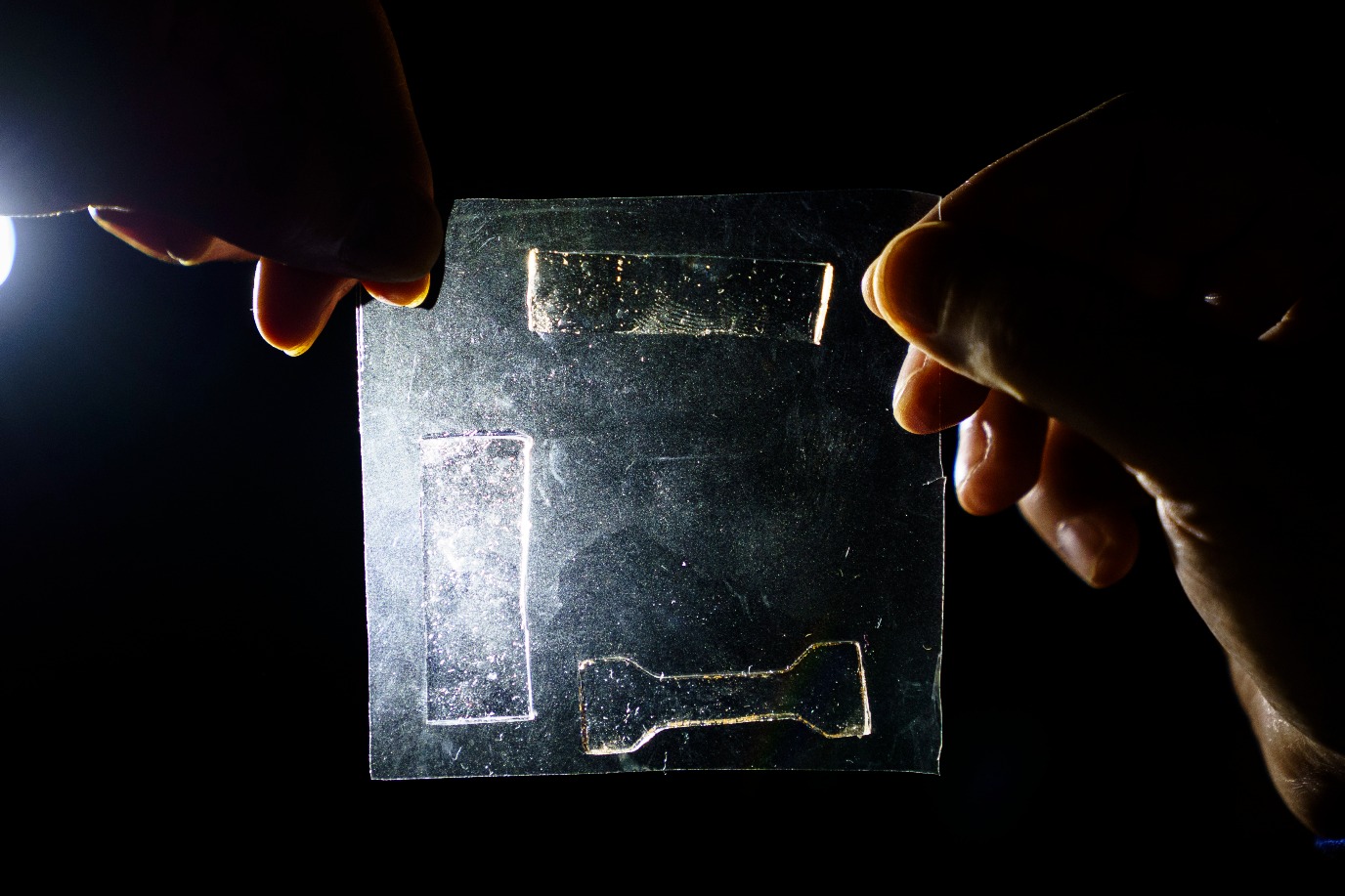Een waterbestendige sensor die zichzelf herstelt
Het rekt, plakt, herstelt zichzelf als er een scheurtje ontstaat, het is water- en vorstbestendig, en het geleidt elektriciteit. Het doorzichtige plakje in deze foto’s is een zogenaamde hydrogel, ontwikkeld door PhD-student Zeyu Zhang onder begeleiding van Patrizio Raffa, hoogleraar Slimme en Duurzame Polymeerproducten. Omdat de geleiding verandert wanneer je het materiaal uitrekt, is het tegelijk een sensor: plak ‘m op je elleboog en je kunt de buiging meten, of plak ‘m op een gebouw in aardbevingsgebied en je kunt de trillingen meten. Zelfs in de regen.



Hydrogels zijn niet nieuw: ‘Het bekendste voorbeeld van een hydrogel is gelatine, het spul dat je in je pudding gebruikt,’ vertelt Raffa. ‘Maar deze hydrogel is veel sterker.’ En de gel kan zichzelf herstellen als hij kapot gaat. Raffa laat in zijn kantoor een dun strookje van het doorzichtige materiaal zien. ‘Kijk, hier zit een scheurtje, zie je dat? Over een paar uur zal dat hersteld zijn.’
Het zelfhelende vermogen was een mooie verrassing, al had Raffa het op basis van de samenstelling al wel gehoopt. Deze hydrogel bevat zogenaamde amphifilische polymeren: lange moleculen met delen die van water houden, en delen die daar niet van houden. ‘Wanneer een breukje ontstaat, zoeken de hydrofobe delen elkaar weer op en vormen zo nieuwe verbindingen.’ Maar Raffa is vooral trots op de waterbestendigheid: ‘Hydrogels zwellen meestal enorm op onder water, maar die van ons niet.’ Dat maakt dat Raffa en Zhang’s hydrogel ook onderwater of in de regen blijft functioneren.
Momenteel werkt Zhang nog verder aan het materiaal, onder andere op zoek naar biologisch afbreekbare alternatieven voor sommige ingrediënten. De volgende stap is de toepassingen uitwerken, iets wat Raffa graag in samenwerking met andere partijen doet. ‘Het zou geweldig zijn als iemand dit ziet en denkt: dat is precies wat ik nodig heb. Dan mogen ze contact met me opnemen.’
Tekst: FSE Science Newsroom | Charlotte Vlek
Foto’s: Reyer Boxem
In Makers van de RUG belichten we elke twee weken een onderzoeker die iets concreets heeft ontwikkeld: van zelfgemaakte meetapparatuur voor wetenschappelijk onderzoek tot kleine of grote producten die ons dagelijks leven kunnen veranderen. Zo dragen RUG-onderzoekers bij aan oplossingen voor grote wetenschappelijke en maatschappelijke uitdagingen.
Techniekonderwijs en -onderzoek maken bij de RUG al decennia deel uit van een breed palet aan sterke disciplines en landelijk werken we steeds intensiever samen met de vier technische universiteiten.
Eerdere portretten van ‘Makers’ vind je op de overzichtspagina
Meer informatie
Meer nieuws
-
06 januari 2026
AI-phasie: kunstmatige intelligentie helpt bij taalgebrek
-
06 januari 2026
Beter zicht op de werkpaarden van ons lichaam
